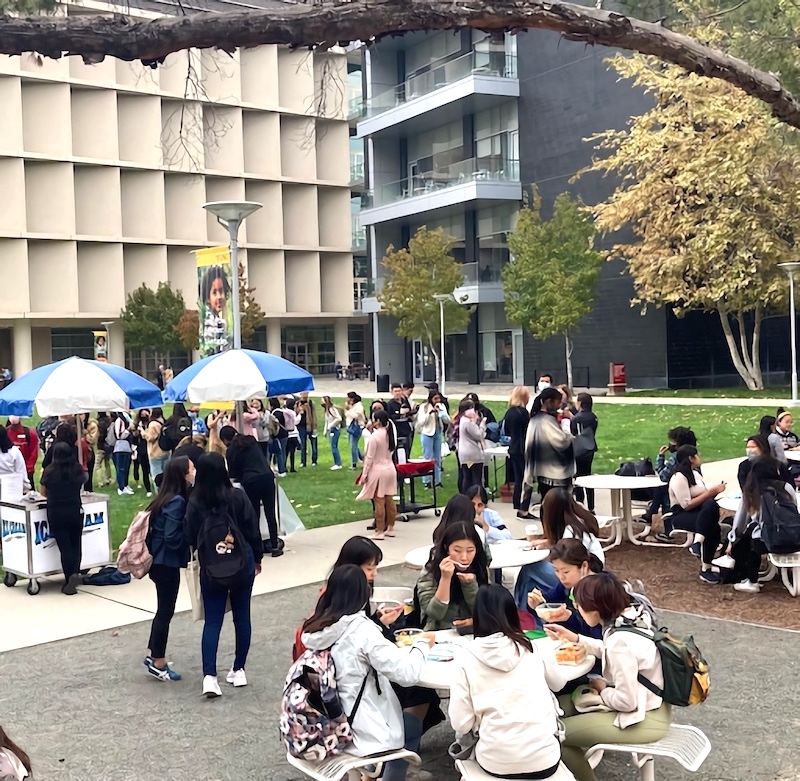Student Blog
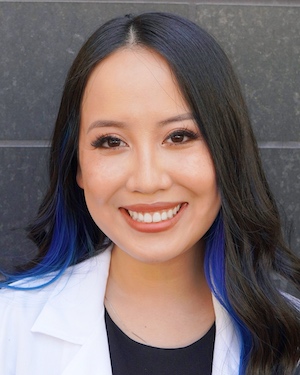
To All the Waitlisted Applicants Ambassadors Have Loved Before: P.S. We Still Love You ⟩
January 27, 2022, by Teresa
If you’re reading this, it’s likely you were waitlisted. If you were waitlisted, you’ve probably been binge-reading some blog posts from ambassadors of years past. You know the ones I’m talking about — those from Calvin, from Liz, from Marilyn, from Daniel, from Kat. Maybe you’ve read them twice. Who are we kidding? You eat, sleep, and breathe their words. You hang onto their stories because they give you hope. They provide comfort when you feel most uncertain, guidance when you can’t find it in those around you, and you exit the tab feeling reassured that everything is going to be okay.
Not too long after, your family asks, “Hey, have you heard back from USC? I know you’ve been waiting.” Maybe you open social media or scour online forums and see all the other students who got in. Or you just interviewed for a part-time job in the meantime and they ask, “Where do you see yourself in 5 years?” Suddenly, things once again do not feel like they’re going to be okay. So you read another blog, go through the same motions, and continue a vicious cycle that doesn’t seem like it’s ever going to end until you finally get the “Congratulations!” email. Even though you know it’s a vicious cycle, you can’t help but feel this way because your life feels like it’s at a standstill, your future lies in the hands of someone else, and you have no control over any of it.
I know the feeling. Replace all the “you”s above with “I” and they were my same thoughts two years ago when I was waitlisted. Although so much time has passed, I still remember it vividly. If you’re looking for another comforting blog, I’m sorry to inform you this is not it. Generations of ambassadors before me have discussed being waitlisted and I highly recommend them all. Here, I want to share with you some things on my mind during this time, never admitted to anyone else, instead internalized, and took with me into the program which manifested as “imposter syndrome.” (But we’ll talk about that another time.) Looking back, I wish I could go back in time, give myself a hug, reframe the negative self-talk, and instead tell myself what I really needed to hear.
“I wasn’t accepted because I am not good enough.”
Maybe you don’t feel you accurately conveyed who you are through your essay (as if anyone could in “X” amount of characte–). Maybe you’re doubting if it was because of the typo you caught after submitting or your improper grammar, even though English isn’t even your first language. Maybe your GPA wasn’t as high because you went to a competitive school, or you worked multiple jobs during college to pay bills and tuition, or you have other living, breathing human beings relying on you for their survival. Do not write any of these off as “excuses” — all of these are very valid. I’m here to tell you all of that is okay, you don’t need to explain yourself to anyone, and this absolutely does not define your worth as a future OT and more importantly, as a human.
“If I don’t get in this year, I should work even harder to get in next year.”
I remember repeating this to myself and to others so often that as I reflect back on it, I want to cry because of how much my heart aches for this person I used to be. In retrospect, I was working so hard that I can’t imagine how I could have worked any harder for the next application cycle. I took on more shifts as a rehab aide and became one of the first people in my circles with COVID. Listen — nothing is worth risking your health. As future OTs, we need to deemphasize “hustle culture,” especially when it infringes upon our health and happiness.
“Even if I do get in now, it’ll only be a pity acceptance. I didn’t deserve it or earn it.”
So yes, if you get accepted now, it’s because someone who was offered a spot turned it down and chose another path for themselves. My advice? I’m a firm believer in putting out the type of energy into the world that I want in return, so for whoever’s spot you’re “taking,” wish them well as they continue on their OT journey. And once you’re in? Focus on yourself and not how others are doing in comparison to you. You’ve been given a clean slate to start over and move forward.
“Everyone else who got in before me will have more time to prepare.”
Even while you’re waitlisted, begin to think about how you’ll handle housing, transportation, and finances. Beyond that, there is little to no preparation required of you. I know people who were accepted the week before, the day before, and even a day after the program had already started. It all works out and here at Chan, they do everything in their power to make sure it does–you need only ask for help. If you were accepted, if you were waitlisted, if you were none of the above and just a random person reading my blog by happenstance, go and LIVE YOUR LIFE!!! Go climb a tree, take a spin class, jump off a plane whilst strapped to another person and relying only on fabric to catch you, learn to sew, hug your dog, kiss your cat, touch some grass, LIVE LIFEEEEEE!!!!!!!!!!! I believe there is no better preparation for starting a graduate program than living your life to the fullest. It is so powerful and restorative to just do something for YOU with no underlying objective other than it would make you happy. It doesn’t advance your career, it doesn’t serve others, it might not even make sense to the world. Take this time to really focus on what makes you happy and think about how you might embed it into your life once you get into school. Engage in your favorite occupations. But safely. I think I’m legally obligated to clarify that I am not liable if you climb a tree. Just kidding (kind of). Live your life. Y’all be safe, though.
“Everyone is going to be so close already and I’m going to feel like an outsider.”
At the start, interactions are so face-value. It’s a lot of small talk, niceties, and formalities. Lots of reading and re-reading your carefully curated introductory profile before posting it. Honestly, it wasn’t until I started the program and got to hear people’s thoughts in class that I thought, “I could really get along with this person on so many levels.” Like yes, it’s so lovely to learn that someone is from the same area as you or that you share the same favorite ice cream flavor, but I came to USC Chan to make meaningful connections with like-minded people whose vulnerability encourages me to grow as a future OT and as a person. Two years later, I’m still having moments like that and making new friends. Don’t worry, there’s time.
“Everyone’s going to know.”
Nobody’s gonna know. How would they know? In fact, most of my classmates who are reading this are probably finding out this information about me for the first time. If you don’t want people to know, you don’t have to tell them. However, if you choose to and people view you differently as a result, it says nothing about who you are.
And most importantly, “I am not going to get any swag.”
“I do not have enough swag,” Teresa writes while sitting atop her mountain of USC Chan pens and foam fingers. “I definitely have more room on my backpack,” she convinces herself while being crushed under the weight of the many buttons she has accumulated over the years. Obviously, I’m kidding. But also . . . get your Chan swag! There will be so many future opportunities and I encourage you to take advantage of them all.
I was actually waitlisted at all three schools I had applied to and told myself I’d commit to wherever I heard from first. I was accepted to all three, with USC being the first and it happened to be my top choice — a big reason for that being the holistic admissions process implemented here and the way Dr. Anvarizadeh spoke about it so passionately. Even though I believe this process to be the most equitable and forward-thinking for the advancement of the OT profession, as with most systems, it is not fail-safe and I knew that going into the application process. I trusted the process anyways, everything worked out how it was supposed to, and I have no regrets, including being waitlisted. It reminded me that who you are on paper and were in the past does not define who you are today and more importantly, who you are on your way to becoming. I feel immensely honored to join the incredible group of ambassadors who were waitlisted and are now some of the most influential mentors I’ve ever had. So whatever the outcome, just know that I’m right here waiting alongside you to join us, too.
Don’t hesitate to reach out to .(JavaScript must be enabled to view this email address) if you’d like to connect!
⋯

Self Care is Health and Health is Wealth ⟩
January 25, 2022, by Silvia
Listen, I know it is admission szn and I will get back to talking more about being first gen, but today is not the day.
Today we’re talking self-care because it is my birthday and I am self-caring all day. I turn twenty-something and normally I would be traveling for my birthday, but birthdays have looked different the last couple of years because #COVID and #GradSchool. It’s hard and stressful to keep up with both. Since starting the master’s program I have been on the “go-go-go” mindset, rarely taking time for myself, but this year I am manifesting better mental health, well-being, and happiness. I am making an effort to invest more time in myself to reset and refill my cup before hitting burnout.
So with that said, let me share with you my top self-care activities.
Watching The Beach Sunrise
This one is probably my favorite one — exceptforthewakingupearlypart — because it truly helps me ground and recenter myself. Sitting in the sand, waiting for the sun to come up, and listening to the waves gives me a sense of peace and fills me with so much gratitude.
I am very future oriented, constantly thinking about tomorrow, and TBH I hate it because it takes away from appreciating where I am at right now. You know the “I’ll be happy when” syndrome. That’s exactly what I’m referring to: I’ll be happy when ______ (I get into the master/OTD program; I pass the comp/NBCOT exam; I graduate; I get my first job . . .). We forget that the moment we are living in right now was once the blank we filled in. So today, I chose to be happy and embrace the fact that I am exactly where I should be.

A Malibu Sunrise
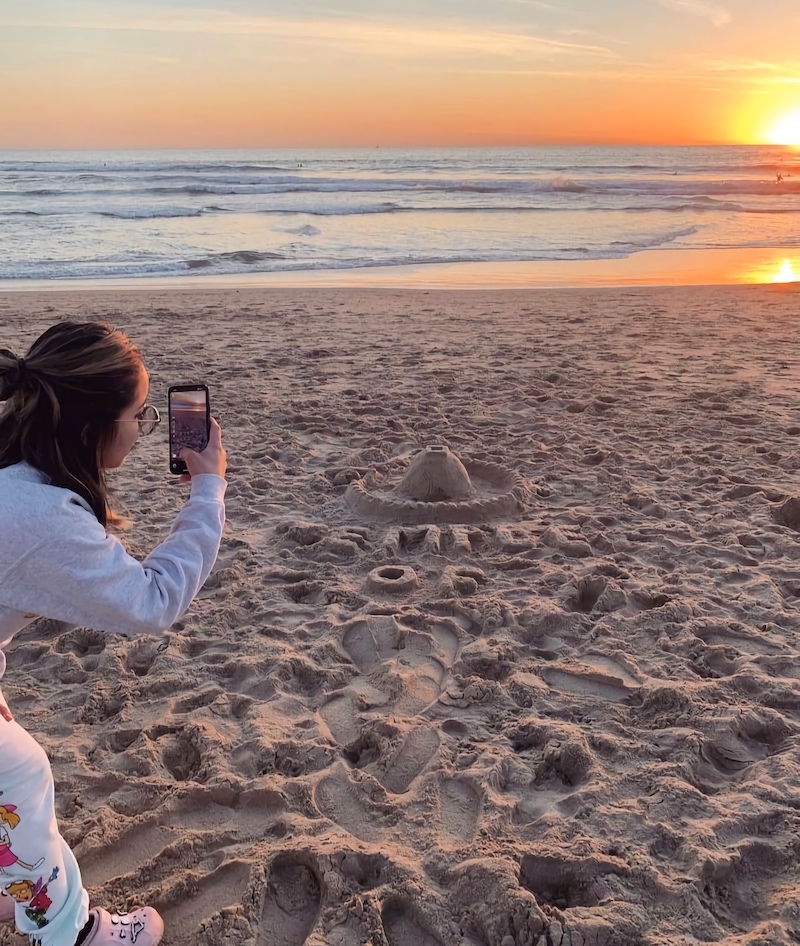
If you don’t make it to sunrise, there’s always sunset 😊
Tips for this self-care activity:
- Go to bed early so you actually wake up to make it to the beach for sunrise
- Bring a book to read or do some mindful coloring
- Grab a hot cup of coffee or tea on the way + dress cozy
Working out
Ok I love this one too — excepttheworkingoutpart — because when you look good, you feel good. I like to start and end my day with a workout. My AM workout is equivalent to a coffee lover’s first sip of coffee in the morning, it wakes my body up and gets me in a good mood. My PM workout helps wind me down after my long days. And in case you were dying to know, I am a big fan of the Apple Fitness HIIT and cycling workouts.
P.S. If you have a workout playlist, please share it.
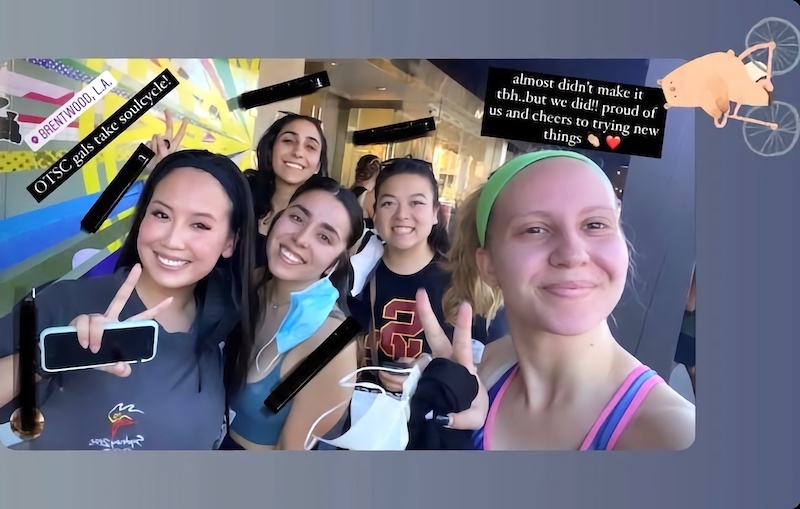
Working out is funner (yes, I know that isn’t a word) with friends; we did a cycling class at SoulCycle. Pictured: Teresa Pham, Me, Mariamme Ibrahim, Alyssa Matlosz, and Vanessa Elshamy
Tips for this self-care activity:
- Try something new/switch it up (let me tell you, I never thought I’d love cycling)
- Put a picture of JLO on your vision board
- Checkout Alyssa’s Zumba class
Treating Myself
Also love this one — exceptthespendingmoneypart — because who doesn’t like to treat themselves?
I must say though, this one can be tricky because it’s really easy to get caught up in the “I deserve it” mindset. And don’t get me wrong, you absolutely do deserve it; however, treating yourself to things only every now-and-then makes them that much more satisfying. OK FINE, this is what I keep telling myself so that I stick to my 2022 budgeting goal — but is it working? Yes. At least January is off to a good start. Now, instead of getting my Vietnamese sweet coffee 3x a week, I save it for the weekend, and in stead of buying a smoothie or acai bowl after my workouts, I make one at home. #GROWTH.
(Obviously except today because it’s my birthday and I’m treating myself.)
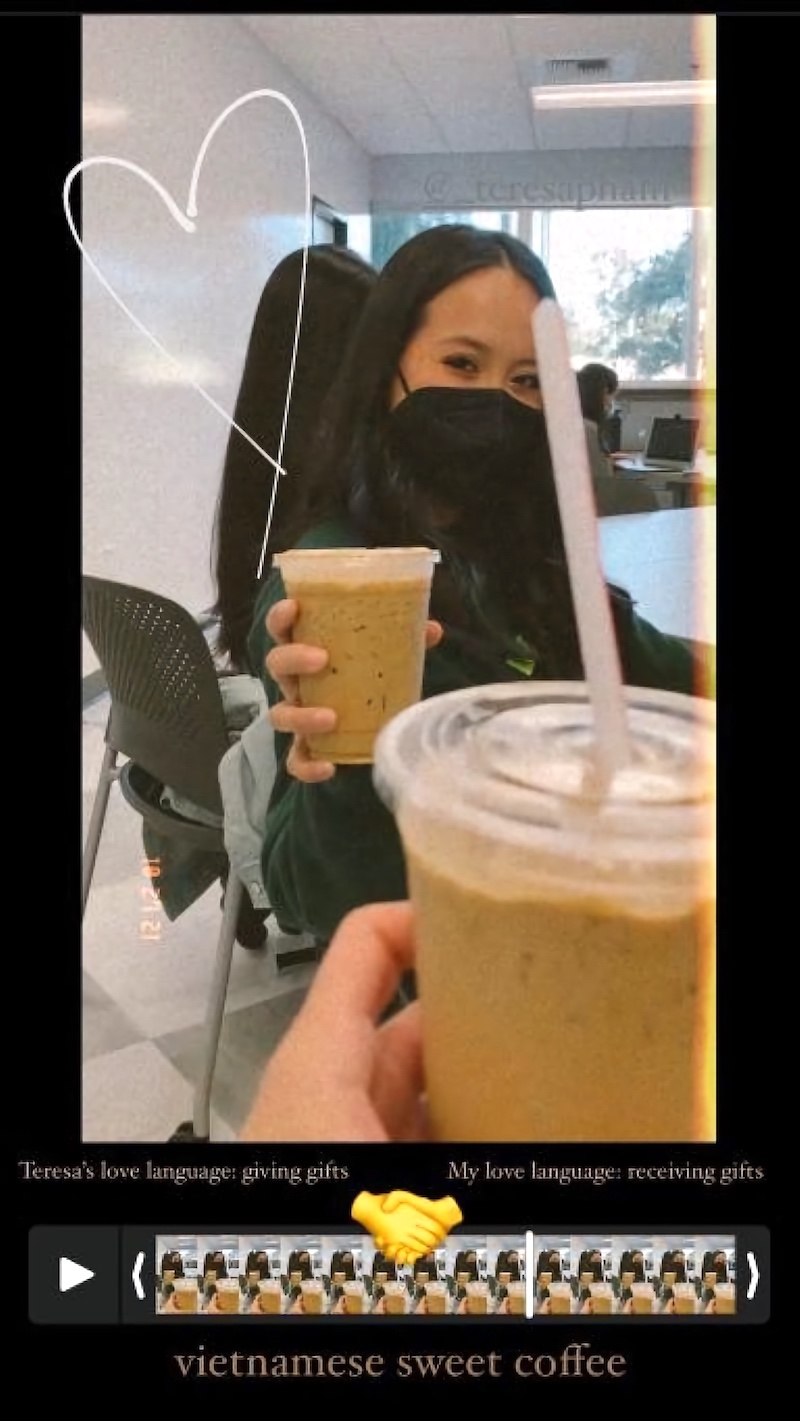
Teresa treating me to a true Vietnamese sweet coffee
Tips for this self-care activity:
- Make a “treat yo self” budget
- Remind yourself you have food/coffee at home during the week
- We’re here for a good time not a long time; if you need to treat yourself, please do
So in conclusion, whether it’s your birthday or not, remember to practice self-care because . . . self-care is health and health is wealth.
⋯

Welcome to Procrastination Nation! ⟩
January 21, 2022, by Seth
Hi, my name is Seth, and I am a chronic procrastinator. If you know me at all, this is probably no shock to you, and if you don’t know me that well, please say hello to what should be my hamartia! While I’m laying all of my cards on the table, I should also confess that I’ve procrastinated writing this blog. To be clear, it’s not because I don’t want to write this blog or that I’m so busy that I have so many other things to take care of, it’s that I just live for a deadline. I’ll explain more on that in a sec, but first, we need to dig into the realities of procrastination first.
Procrastination is often only portrayed as this debilitating habit that we must overcome to become masters of time management and there is truth to this! I’m sure many of us are too familiar with procrastination that has been taken too far. Who can’t recall the time they cut things too close or ended up not showcasing our best work? This is a reality of procrastination, but it is not the only reality. Real-life is rarely this black and white and there are some theories to back this up! The Yerkes-Dodson Model (1908) details a quadratic relationship between arousal and performance where there is a range of optimality. Another way to talk about this in occupational therapy is a challenge-skill relationship where that optimal range results in a flow experience; one of complete immersion in the task at hand.
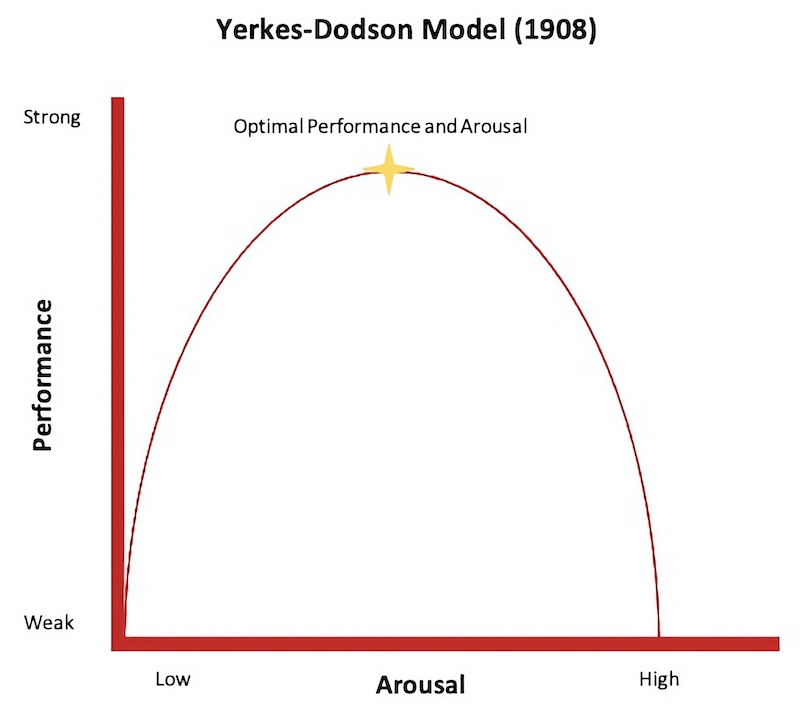
Here’s a visual of the Yerkes-Dodson Model! Everyone’s graph looks different depending on their own internal relationship to arousal and performance.
This is to say that eustress, or good stress, can improve the work you have just as much as the other ranges in this relationship can negatively impact your work. While operating under this perspective I have come to find that, for me, procrastination is less about time management and more about emotional management. Earlier I mentioned that I live for a deadline and this is why! I manufactured the perfect challenge for what I perceive to be my skill and viola! I finally get to the work at hand. By now you’re probably thinking, “This is great news, Seth! I feel so validated, but knowing this doesn’t change the feeling in my gut when I’m procrastinating.” And I’m right there with you, so here are some of the thing’s I’ve found that help me work through that feeling:
Using an Eisenhower Box
The strategy I always have in my back pocket and my first line of defense is the Eisenhower Box. This tool is essentially a way to organize tasks into four quadrants based on urgency and importance. Although I’ve found this is a great way to strategize, I always let my gut feeling play a role in the decision-making process, and I encourage you to do the same.

Here’s an example of my Eisenhower box at the moment! It’s constantly changing and even the tasks showed here can switch quadrants depending on when I re-evaluate my box.
Productive Procrastination
Maybe the best strategy I’ve used to generate enough stress to reach my optimal level is to productively procrastinate. This may mean tackling some of the more non-urgent and less important tasks in your Eisenhower box. This often manifests in cleaning your entire living area before starting your readings or just absolutely having to run that errand before writing that paper. This allows you to get other things done while slowly restricting the avenues you have to procrastinate. This leads me to my next point!
Removing Distractions
This is a natural extension of productive procrastination but goes beyond the things that are also on our to-do lists. I’m talking about our phones, the show we’re binge-watching, or the roommate who decided to invite company over right before that first big assignment is due. For me, this means putting my phone in some random drawer in the kitchen, sitting in a place that is not my bed, and either having absolute silence or music that drowns out whatever other noise is around. Take a look at the things that usually distract you and brainstorm ways to work around them.
Diaphragmatic Breathing
Whenever I think about this strategy, I laugh because breathing exercises have always ended up stressing me out more, but this one is a game-changer. Breathing from the abdomen (as opposed to the chest) is a quick way to elicit relaxation. It can release muscle tension, slow the heart rate, and lead to a hearty supply of oxygen to the blood. Try breathing from your chest and then your abdomen, then take note of any difference. If you’re procrastinating and find yourself starting to breathe from the chest, switch the style up.
Knowing Yourself and the Resources Available
I gave a couple of suggestions that have worked for me, but what it all comes down to is knowing yourself! Reflect on how long things have taken you before, your performance on these tasks, and what strategies work for you in managing your stress and procrastination. If you’re trying to find your optimal performance-arousal range, take note of the stress signs that start manifesting for yourself. Figure out when you’re most productive and take advantage of that time (but don’t be afraid to dedicate it to more meaningful occupations too). If you need some help, don’t be afraid to ask! The USC Kortschak Center, an occupational therapy collaborative resource center, has plenty of strategies and consultations that can get you on the best path for you.
Don’t get me wrong, I am not necessarily endorsing procrastination. All, some, or none of this may resonate with you, but I hope that it encourages you to reflect on your procrastination habits. As we head into the third week of the spring semester, I invite everyone to give themselves a little more grace around their habits. Coming around to see that there can be ambivalence around procrastination is a great step in making positive change. It helps us shift the narrative from thinking “I should stop procrastinating” to “I could do XYZ” to make that change more manageable, intentional, and personalized. So get out there and make the change, or put it off until tomorrow! Either way, I hope you’ve enjoyed your stay in Procrastination Nation.
⋯
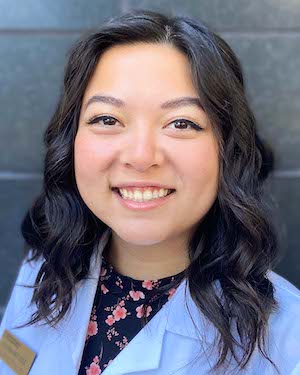
Hello Trello ⟩
January 19, 2022, by Alyssa
Happy new year/new semester to all! Continuing from my last blog, let’s get organized for the semester.
I live laugh love ride and die by my Trello boards. I was introduced to Trello in a coding class in undergrad for the classic use of “to do” “doing” and “done” lists. As someone whose work style leans toward start-to-finish in one sitting, this workflow doesn’t really work for me. Trello is also built for team workflows in mind BUT I realized Trello had a lot to offer for personal organization.
My system is intuitive to me but challenging to explain, so here it is in 4 parts.
1. Multiple boards/visualizations
There are 3 main parts to the anatomy of Trello. “Cards” are single events/tasks. “Lists” are lists of cards. “Boards” are pages of lists. Within each card, you can add sub-checklists, descriptions, and attachments.
I operate my life around 2 boards: my due dates and my schedule. As soon as the syllabus is released each semester, I input all of the due dates into my board and color code them (see #2). This board can be viewed as lists for each class or as an auto-populated calendar of due dates.

Anatomy of a Trello board, featuring one of my class due date lists.
I then update my schedule board roughly every month to schedule out when I’m going to all of that work around my regularly scheduled events (class, appointments, etc.). I add in personal plans and other to-dos as they come up.
2. Color coding
Trello offers 10 colors to label each card. I use these colors differently for each board.
For my due date board, each class gets its own color, and then I additionally categorize each task by type. Yellow for readings, Red for big assignments/exams, Orange for anything in between.
My schedule board is a bit more complicated: class (light blue), homework (dark blue), fieldwork (black) student ambassador work (yellow), OTSC (orange), any other club (mint), important personal to-dos (red), social plans (pink), workouts (purple). I do this so I can see the balance of my day/week. If I notice too much dark blue, I’ll try and rearrange to make sure I have some restorative pink or purple in there.
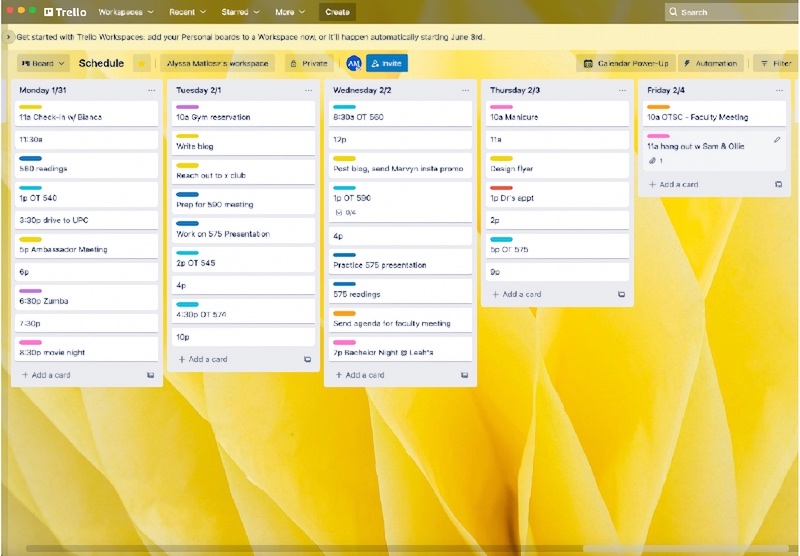
A mock-up of one of my weekly schedules on my Trello schedule board.
3. Keyboard shortcuts
Trello has keyboard shortcuts to add due dates, label cards with colors, create cards from templates, and quickly switch between boards. Using these shortcuts dramatically increases the efficiency of using Trello for scheduling.
My favorite one is hovering a card and pressing C and it disappears, which is how I mark something as ‘done’ — a thrilling mix of achievement and relief.
4. Drag and drop
If I don’t get something done when I planned to, I like how Trello has an easy drag-and-drop feature for the cards. It lets me quickly rearrange my plans/tasks without having to rewrite anything. Honestly, it feels way less shameful and I see it as a metaphor for trying to be more flexible and give myself some more grace.
⋯
Friendtorship Circles 2021-2022 ⟩
January 18, 2022, by Global Initiatives Team
By Brendan La Scala, OTR, Global Initiatives Doctoral Candidate
Editors Alison Chang and Vanessa ElShamy
Entry-Level Professional Master’s students
Danny Park OTD, OTR/L (pictured on the right) and Brendan LaScala, OTD student (pictured on the left) at the ice cream social/Friendtorship mixer in November 2021
This semester, Global Initiatives hosted our first in-person Friendtorship (friendship + mentorship) Circles event for the USC Chan community. Friendtorship Circles were intentionally created with students in our Post-Professional Master’s, Entry-Level Master’s (first and second years), OTD, PhD, Bachelor’s to Master’s, and Bachelor’s to Doctorate programs. Meetings were held one time per month, with each event including large and small group discussions and activities for students to get to know each other.
The Friendtorship Circles were started in the summer of 2020 as a product of the Chan Community Commission, a student initiative that aims to help cultivate connections between incoming Master’s students. Second-year Professional Master’s students formed this commission, recognizing the importance of social connection, having received a significant portion of their education experience remotely. At the end of the summer, Global Initiatives decided to add the Friendtorship Circles to their programming with a focus on the international student population.
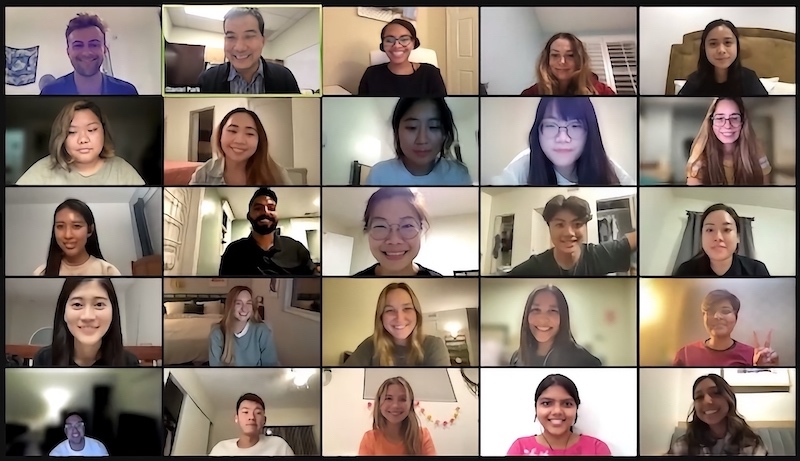
First virtual Friendtorship Event
Students took the time out of their busy schedules to share moments with other students, some whom they had never met before; this represents the nature of the occupational therapy community. Our very own Josh Digao (MA-1) stated that, “Friendtorship was a way for me to connect with people I would have never met otherwise and I am grateful that Global Initiatives provided this amazing opportunity to us.” The Friendtorship Circles served our community by providing an avenue for international students to get to know local students from other cohorts in the Chan Division. Below are some pictures from our time together during the Fall semester. I am personally excited to continue this effort as a member of the Friendtorship planning committee and plan to help expand the program this Spring semester!
First in-person Friendtorship event with groups pictured on the Broad Lawn during a surprisingly gloomy day at the USC Health Science Campus
⋯







